Strength and Durability of Sustainable Self-Consolidating Concrete with High Levels of Supplementary Cementitious Materials
Abstract
1. Introduction
2. Materials and Methods
2.1. Experimental Program
2.2. Testing Procedures
3. Results and Discussion
3.1. Workability
3.1.1. Slump Flow
3.1.2. V-Funnel Test
3.1.3. L-Box Test
3.1.4. J-Ring Test
3.2. Mechanical Performance
Compressive Strength
3.3. Durability
3.3.1. Water Permeability
3.3.2. Water Absorption
3.3.3. Rapid Chloride Penetration Test (RCPT)
4. Conclusions
- In this investigation, GGBS and MS were able to be used at levels up to 71%. A sustainable and durable SCC was successfully produced.
- The high surface area of the SCM particles has increased both the initial slump and 60 min slump for the SCC in comparison to the 100% OPC-SCC. An appropriate time for handling and casting was registered. Moreover, SCC with high contents of SCMs showed the ability to be self-leveled with passing ability through reinforcement without segregation.
- Viscosity for SCC was decreased in mixtures containing fly ash, while with GGBS the viscosity was increased. The results showed adequate FA-SCC filling ability and low rate of flow with congested reinforcement, whereas GGBS increased the viscosity and consequently increased the SCC rate of flow. There was no bleeding and no segregation, which reflects an advanced mixture design. Flow spreadability was increased for SCCs with high levels of SCMs, which reflects the ability to flow and fill congested reinforcement formwork without segregation or blocking. SCC showed a higher passing ratio based on L-box test results.
- The synergy of high-content MS with FA or MS with GGBS was a clear factor in producing high-strength SCC. MS worked as a reactor to activate the potential chemical power in SCMs and react with Ca(OH)2 to form more calcium silicate hydrate (C-S-H).
- The combination of very fine SCMs in SCC showed an advanced interaction producing very dense cement gel with good compactness for the paste. The result showed sophisticated water permeability which is related to the effect of the increase in the hydration products and good compactness of different aggregate sizes and fine sand particles. Water permeability in SCC concrete was reduced to zero due to the effective changes in the gel pore system. Water penetration ability was reduced due to the final hydration products of high replacement levels of SCMs which reduced pore volume and changed pore structure.
Author Contributions
Funding
Institutional Review Board Statement
Informed Consent Statement
Data Availability Statement
Acknowledgments
Conflicts of Interest
References
- Okamura, H.; Ouchi, M. Self-compacting concrete. J. Adv. Concr. Technol. 2003, 1, 5–15. [Google Scholar] [CrossRef]
- Concrete, S.-C. The European Guidelines for Self-Compacting Concrete. BIBM 2005, 22, 563. [Google Scholar]
- Esfandiari, J.; Loghmani, P. Effect of perlite powder and silica fume on the compressive strength and microstructural characterization of self-compacting concrete with lime-cement binder. Measurement 2019, 147, 106846. [Google Scholar] [CrossRef]
- Shi, C.; Wu, Z.; Lv, K.; Wu, L. A review on mixture design methods for self-compacting concrete. Constr. Build. Mater. 2015, 84, 387–398. [Google Scholar] [CrossRef]
- Mohamed, H.A. Effect of fly ash and silica fume on compressive strength of self-compacting concrete under different curing conditions. Ain Shams Eng. J. 2011, 2, 79–86. [Google Scholar] [CrossRef]
- ACI Concrete Terminology; American Concrete Institute. In Ferrocement. 2013. Available online: https://www.concrete.org/topicsinconcrete/topicdetail/ferrocement (accessed on 11 May 2019).
- Khayat, K.H.; De Schutter, G. Mechanical Properties of Self-Compacting Concrete: State-of-the-Art Report of the RILEM Technical Committee 228-MPS on Mechanical Properties of Self-Compacting Concrete; Springer Science & Business Media: Berlin/Heidelberg, Germany, 2014; Volume 14. [Google Scholar]
- BS EN 206:2013; Concrete-Specification, Performance, Production and Conformity. The British Standards Institution, BSI Standards Limited: London, UK, 2014.
- Shi, C.; Wu, Y. Mixture proportioning and properties of self-consolidating lightweight concrete containing glass powder. ACI Mater. J. 2005, 102, 355. [Google Scholar]
- Wang, X.; Wang, K.; Taylor, P.; Morcous, G. Assessing particle packing based self-consolidating concrete mix design method. Constr. Build. Mater. 2014, 70, 439–452. [Google Scholar] [CrossRef]
- Siddique, R.; Aggarwal, P.; Aggarwal, Y. Mechanical and durability properties of self-compacting concrete containing fly ash and bottom ash. J. Sustain. Cem.-Based Mater. 2012, 1, 67–82. [Google Scholar] [CrossRef]
- Esmaeilkhanian, B.; Khayat, K.H.; Yahia, A.; Feys, D. Effects of mix design parameters and rheological properties on dynamic stability of self-consolidating concrete. Cem. Concr. Compos. 2014, 54, 21–28. [Google Scholar] [CrossRef]
- Owsiak, Z.; Grzmil, W. The evaluation of the influence of mineral additives on the durability of self-compacting concretes. KSCE J. Civ. Eng. 2015, 19, 1002–1008. [Google Scholar] [CrossRef]
- Ashish, D.K. Feasibility of waste marble powder in concrete as partial substitution of cement and sand amalgam for sustainable growth. J. Build. Eng. 2018, 15, 236–242. [Google Scholar] [CrossRef]
- Technical Report No. 74, Cementitious Materials, The Effect of Ggbs, Fly Ash, Silica Fume and Limestone Fines on the Properties of Concrete. 2011. Available online: www.concrete.org.uk (accessed on 11 May 2019).
- Cement Association of Canada. Sustainable Cement Manufacturing. Available online: https://www.cement.ca/sustainability/# (accessed on 11 May 2019).
- Rajhans, P.; Panda, S.K.; Nayak, S. Sustainable self compacting concrete from C&D waste by improving the microstructures of concrete ITZ. Constr. Build. Mater. 2018, 163, 557–570. [Google Scholar]
- Revilla-Cuesta, V.; Skaf, M.; Faleschini, F.; Manso, J.M.; Ortega-López, V. Self-compacting concrete manufactured with recycled concrete aggregate: An overview. J. Clean. Prod. 2020, 262, 121362. [Google Scholar] [CrossRef]
- Rojo-López, G.; Nunes, S.; González-Fonteboa, B.; Martínez-Abella, F. Quaternary blends of portland cement, metakaolin, biomass ash and granite powder for production of self-compacting concrete. J. Clean. Prod. 2020, 266, 121666. [Google Scholar] [CrossRef]
- Salih, M.A. Strength And Durability of High Performance Concrete Containing Fly Ash and Micro Silica. Intern. J. Civ. Eng. Technol. (IJCIET) 2018, 9, 104–114. [Google Scholar]
- Salih, M.; Ahmed, S. Mix Design for Sustainable High Strength Concrete by Using GGBS and Micro Silica as Supplementary Cementitious Materials. Int. Rev. Civ. Eng. (IRECE) 2020, 11, 45. [Google Scholar] [CrossRef]
- Salih, M. Durability of Concrete Containing Different Levels of Supplementary Cementitious Materials. Int. Rev. Civ. Eng. (IRECE) 2018, 9, 241. [Google Scholar]
- Le, H.T.; Ludwig, H.-M. Effect of rice husk ash and other mineral admixtures on properties of self-compacting high performance concrete. Mater. Des. 2016, 89, 156–166. [Google Scholar] [CrossRef]
- Łaźniewska-Piekarczyk, B. The influence of chemical admixtures on cement hydration and mixture properties of very high performance self-compacting concrete. Constr. Build. Mater. 2013, 49, 643–662. [Google Scholar] [CrossRef]
- Kavitha, S.; Kala, T.F. Evaluation of strength behavior of self-compacting concrete using alccofine and GGBS as partial replacement of cement. Indian J. Sci. Technol. 2016, 9, 1–5. [Google Scholar] [CrossRef]
- Sharbaf, M.; Najimi, M.; Ghafoori, N. A comparative study of natural pozzolan and fly ash: Investigation on abrasion resistance and transport properties of self-consolidating concrete. Constr. Build. Mater. 2022, 346, 128330. [Google Scholar] [CrossRef]
- Tadi, C.; Rao, T.C. Investigating the performance of self-compacting concrete pavement containing GGBS. Mater. Today: Proc. 2022, 49, 2013–2018. [Google Scholar] [CrossRef]
- Sun, Z.; Young, C. Bleeding of SCC pastes with fly ash and GGBFS replacement. J. Sustain. Cem. Based Mater. 2014, 3, 220–229. [Google Scholar] [CrossRef]
- Memon, S.A.; Shaikh, M.A.; Akbar, H. Utilization of Rice Husk Ash as viscosity modifying agent in Self Compacting Concrete. Constr. Build. Mater. 2011, 25, 1044–1048. [Google Scholar] [CrossRef]
- Abd El Aziz, M.; Abd El Aleem, S.; El Heikal, M.; Didamony, H. Hydration and durability of sulphate-resisting and slag cement blends in Caron’s Lake water. Cem. Concr. Res. 2005, 35, 1592–1600. [Google Scholar] [CrossRef]
- Khan, M.I.; Siddique, R. Utilization of silica fume in concrete: Review of durability properties. Resour. Conserv. Recycl. 2011, 57, 30–35. [Google Scholar] [CrossRef]
- Hanif, A.; Lu, Z.; Li, Z. Utilization of fly ash cenosphere as lightweight filler in cement-based composites—A review. Constr. Build. Mater. 2017, 144, 373–384. [Google Scholar] [CrossRef]
- Elemam, W.E.; Abdelraheem, A.H.; Mahdy, M.G.; Tahwia, A.M. Prediction and Optimization of Self-Consolidating Concrete Properties. ACI Mater. J. 2022, 119, 91–104. [Google Scholar]
- Li, G.; Zhao, X. Properties of concrete incorporating fly ash and ground granulated blast-furnace slag. Cem. Concr. Compos. 2003, 25, 293–299. [Google Scholar] [CrossRef]
- Berndt, M.L. Properties of sustainable concrete containing fly ash, slag and recycled concrete aggregate. Constr. Build. Mater. 2009, 23, 2606–2613. [Google Scholar] [CrossRef]
- Liu, Y.; Zhou, X.; Lv, C.; Yang, Y.; Liu, T. Use of Silica Fume and GGBS to Improve Frost Resistance of ECC with High-Volume Fly Ash. Adv. Civ. Eng. 2018, 2018, 11. [Google Scholar] [CrossRef]
- Schneider, M. Process technology for efficient and sustainable cement production. Cem. Concr. Res. 2015, 78, 14–23. [Google Scholar] [CrossRef]
- Choudhary, R.; Gupta, R.; Nagar, R.; Jain, A. Mechanical and abrasion resistance performance of silica fume, marble slurry powder, and fly ash amalgamated high strength self-consolidating concrete. Constr. Build. Mater. 2021, 269, 121282. [Google Scholar] [CrossRef]
- Mohan, A.; Mini, K. Strength and durability studies of SCC incorporating silica fume and ultra fine GGBS. Constr. Build. Mater. 2018, 171, 919–928. [Google Scholar] [CrossRef]
- Kanellopoulos, A.; Savva, P.; Petrou, M.F.; Ioannou, I.; Pantazopoulou, S. Assessing the quality of concrete–reinforcement interface in Self Compacting Concrete. Constr. Build. Mater. 2020, 240, 117933. [Google Scholar] [CrossRef]
- Zhao, H.; Sun, W.; Wu, X.; Gao, B. The properties of the self-compacting concrete with fly ash and ground granulated blast furnace slag mineral admixtures. J. Clean. Prod. 2015, 95, 66–74. [Google Scholar] [CrossRef]
- Liu, M. Self-compacting concrete with different levels of pulverized fuel ash. Constr. Build. Mater. 2010, 24, 1245–1252. [Google Scholar] [CrossRef]
- Siddique, R. Properties of self-compacting concrete containing class F fly ash. Mater. Des. 2011, 32, 1501–1507. [Google Scholar] [CrossRef]
- Uysal, M.; Sumer, M. Performance of self-compacting concrete containing different mineral admixtures. Constr. Build. Mater. 2011, 25, 4112–4120. [Google Scholar] [CrossRef]
- Sharma, R.; Khan, R.A. Sustainable use of copper slag in self compacting concrete containing supplementary cementitious materials. J. Clean. Prod. 2017, 151, 179–192. [Google Scholar] [CrossRef]
- Tavasoli, S.; Nili, M.; Serpoush, B. Effect of GGBS on the frost resistance of self-consolidating concrete. Constr. Build. Mater. 2018, 165, 717–722. [Google Scholar] [CrossRef]
- Vivek, S.S.; Dhinakaran, G. Fresh and hardened properties of binary blend high strength self compacting concrete. Eng. Sci. Technol. Int. J. 2017, 20, 1173–1179. [Google Scholar] [CrossRef]
- Massana, J.; Reyes, E.; Bernal, J.; León, N.; Sánchez-Espinosa, E. Influence of nano- and micro-silica additions on the durability of a high-performance self-compacting concrete. Constr. Build. Mater. 2018, 165, 93–103. [Google Scholar] [CrossRef]
- Leung, H.Y.; Kim, J.; Nadeem, A.; Jaganathan, J.; Anwar, M.P. Sorptivity of self-compacting concrete containing fly ash and silica fume. Constr. Build. Mater. 2016, 113, 369–375. [Google Scholar] [CrossRef]
- Castro, J.; Bentz, D.; Weiss, J. Effect of sample conditioning on the water absorption of concrete. Cem. Concr. Compos. 2011, 33, 805–813. [Google Scholar] [CrossRef]
- BS 196-6:1992; Methods of Testing Cement. In Part 6: Determination of Fineness. BSI: London, UK, 1992.
- BS EN 197-1:2000; In Part 1: Composition, Specifications and Conformity Criteria for Common Cements. BSI: London, UK, 2000.
- BS EN 15167-1:2006; Ground Granulated Blast Furnace Slag for Use in Concrete, Mortar and Grout. BSI: London, UK, 2006.
- Neville, A.M. Properties of Concrete; Longman: London, UK, 2011; Volume 4. [Google Scholar]
- ASTM C 494/C 494M-19; Standard Specification for Chemical Admixtures for Concrete. ASTM International: West Conshohocken, PA, USA, 2019.
- BS EN 934-2; Admixtures for Concrete, Mortar and Grout. BSI: London, UK, 1998.
- CONMIX LTD. MegaFlow 2000, Polycarboxylated High Range Superplasticiser, 2020. Available online: www.conmix.com (accessed on 11 May 2019).
- C311, A; Standard Test Methods for Sampling and Testing Fly Ash or Natural Pozzolans for Use as a Mineral Admixture in Portland-Cement Concrete. ASTM International: West Conshohocken, PA, USA, 2000.
- ASTM C1611/C1611M-05; Standard Test Method for Slump Flow of Self-Consolidating Concrete. ASTM International: West Conshohocken, PA, USA, 2009.
- EFNARC. The European Guidelines for Self-Compacting Concrete. In Specification, Production and Use; EFNARC: London, UK, 2005. [Google Scholar]
- EN 12350-8; Testing Fresh Concrete—Part 8: Self-Compacting Concrete—Slump-Flow Test. BSI: London, UK, 2010.
- EN 12350-9; Testing Fresh Concrete—Part 9: Self-Compacting Concrete—V Funnel Test. BSI: London, UK, 2010.
- EN 12350-10; Testing Fresh Concrete—Part 10: Self-Compacting Concrete—L Box Test. BSI: London, UK, 2010.
- EN 12350-12; Testing Fresh Concrete—Part 12: Self-Compacting Concrete—J Ring Test. BSI: London, UK, 2010.
- BS 1881—122:2011 + A1; Testing Concrte Method for Determination of Water Absorption. BSI: London, UK, 2020.
- EN 12390-8; Depth of Penetration of Water under Pressure. BSI: London, UK, 2000.
- C1202-17a; Standard Test Method for Electrical Indication of Concrete’s Ability to Resist Chloride Ion Penetration. ASTM: West Conshohocken, PA, USA, 2017.
- Kumar, M.P.; Mini, K.M.; Rangarajan, M. Ultrafine GGBS and calcium nitrate as concrete admixtures for improved mechanical properties and corrosion resistance. Constr. Build. Mater. 2018, 182, 249–257. [Google Scholar] [CrossRef]
- Li, L.G.; Zheng, J.Y.; Zhu, J.; Kwan, A.K.H. Combined usage of micro-silica and nano-silica in concrete: SP demand, cementing efficiencies and synergistic effect. Constr. Build. Mater. 2018, 168, 622–632. [Google Scholar] [CrossRef]
- Oner, A.; Akyuz, S. An experimental study on optimum usage of GGBS for the compressive strength of concrete. Cem. Concr. Compos. 2007, 29, 505–514. [Google Scholar] [CrossRef]
- Aldred, J.M.; Holland, T.C.; Morgan, D.R.; Roy, D.M.; Bury, M.A.; Hooton, R.D.; Olek, J.; Scali, M.J.; Detwiler, R.J.; Jaber, T.M. ACI 234R Guide for the Use of Silica Fume in Concrete; ACI–American Concrete Institute–Committee: Farmington Hills, MI, USA, 2006; Volume 234. [Google Scholar]
- EFNARC. Guidelines for Self-Compacting Concrete; Association House: London, UK, 2002; Volume 32, p. 34. [Google Scholar]
- Concrete Society. Technical Report No. 40, The Use of GGBS and PFA in Concrete; The Concrete Society: Slough, UK, 2008. [Google Scholar]
- C1621/C1621M; Standard Test Method for Passing Ability of Self-Consolidating Concrete by J-Ring. ASTM: West Conshohocken, PA, USA, 2017.
- Rajhans, P.; Panda, S.K.; Nayak, S. Sustainability on durability of self compacting concrete from C&D waste by improving porosity and hydrated compounds: A microstructural investigation. Constr. Build. Mater. 2018, 174, 559–575. [Google Scholar]
- Guo, Z.; Jiang, T.; Zhang, J.; Kong, X.; Chen, C.; Lehman, D.E. Mechanical and durability properties of sustainable self-compacting concrete with recycled concrete aggregate and fly ash, slag and silica fume. Constr. Build. Mater. 2020, 231, 117115. [Google Scholar] [CrossRef]
- Celik, K.; Meral, C.; Petek Gursel, A.; Mehta, P.K.; Horvath, A.; Monteiro, P.J.M. Mechanical properties, durability, and life-cycle assessment of self-consolidating concrete mixtures made with blended portland cements containing fly ash and limestone powder. Cem. Concr. Compos. 2015, 56, 59–72. [Google Scholar] [CrossRef]
- ACI Committee. 234R-06: Guide for the Use of Silica Fume in Concrete; ACI Committee: Farmington Hills, MI, USA, 2012. [Google Scholar]
- Midgley, H.G.; Illston, J.M. The penetration of chlorides into hardened cement pastes. Cem. Concr. Res. 1984, 14, 546–558. [Google Scholar] [CrossRef]
- Ng, P.-L.; Kwan, A.K.-H.; Li, L.G. Packing and film thickness theories for the mix design of high-performance concrete. J. Zhejiang Univ. Sci. A 2016, 17, 759–781. [Google Scholar] [CrossRef]
- Kwan, A.K.H.; Wong, H.H.C. Packing density of cementitious materials: Part 2—packing and flow of OPC + PFA + CSF. Mater. Struct. 2007, 41, 773. [Google Scholar] [CrossRef]
- Mehta, P.K.; Monteiro, P.J. Concrete: Microstructure, Properties, and Materials; McGraw-Hill: New York, NY, USA, 2006; Volume 3. [Google Scholar]
- Dordi, C.M.; Vyasa Rao, A.N.; Santhanam, M. Microfine Gound Granulated Blast Furnace Slag For High Performance Concrete. In Proceedings of the Third International Conference on Sustainable Construction Materials and Technologies, Kyoto, Japan, 18–21 August 2013. [Google Scholar]
- Neville, A.M. Properties of Concrete; Longman: London, UK, 1995; Volume 4. [Google Scholar]
- Lamond, J.F.; Pielert, J.H. Significance of Tests and Properties of Concrete and Concrete-Making Materials; ASTM: West Conshohocken, PA, USA, 2006. [Google Scholar]
- Hall, C. Water sorptivity of mortars and concretes: A review. Mag. Concr. Res. 1989, 41, 51–61. [Google Scholar] [CrossRef]
- Henkensiefken, R.; Castro, J.; Bentz, D.; Nantung, T.; Weiss, J. Water absorption in internally cured mortar made with water-filled lightweight aggregate. Cem. Concr. Res. 2009, 39, 883–892. [Google Scholar] [CrossRef]
- Powers, T.C.; Brownyard, T.L. Studies of the Physical Properties of Hardened Portland Cement Paste. J. Proc. 1946, 43, 101–132. [Google Scholar]
- Mehta, P.; Gjørv, O. Properties of portland cement concrete containing fly ash and condensed silica-fume. Cem. Concr. Res. 1982, 12, 587–595. [Google Scholar] [CrossRef]
- Bickley, J.; Ryell, J.; Rogers, C.; Hooton, R. Some characteristics of high-strength structural concrete. Can. J. Civ. Eng. 1991, 18, 885–889. [Google Scholar] [CrossRef]
- Yazıcı, H. The effect of silica fume and high-volume Class C fly ash on mechanical properties, chloride penetration and freeze–thaw resistance of self-compacting concrete. Constr. Build. Mater. 2008, 22, 456–462. [Google Scholar] [CrossRef]

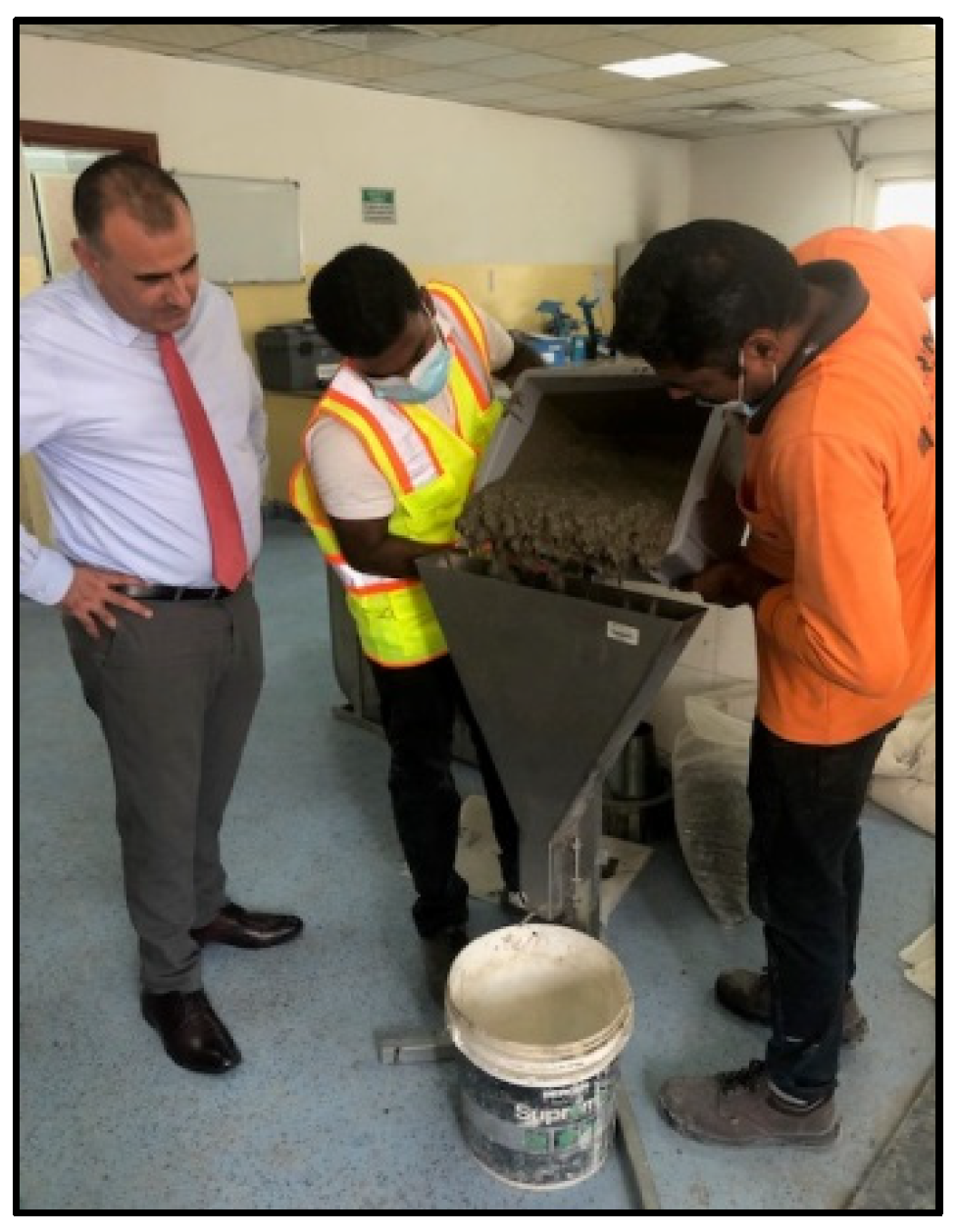
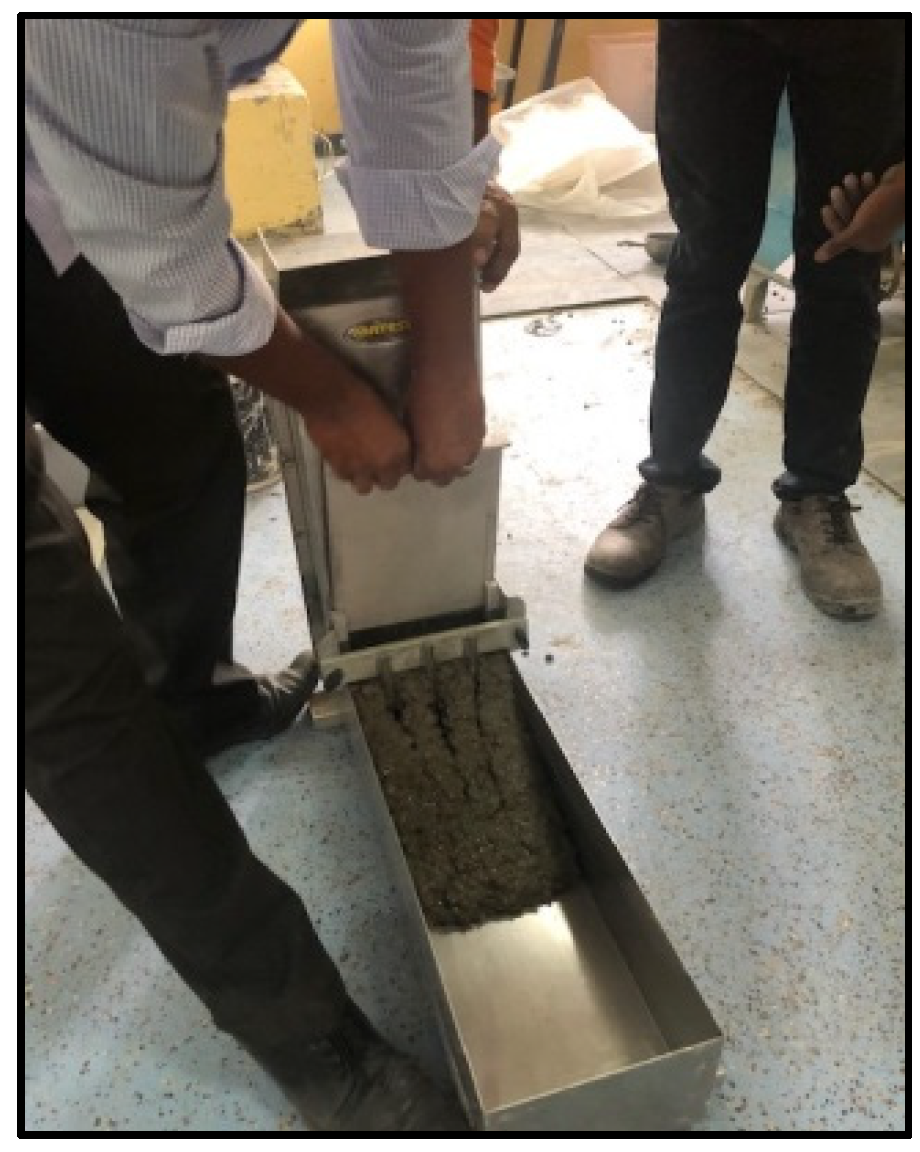
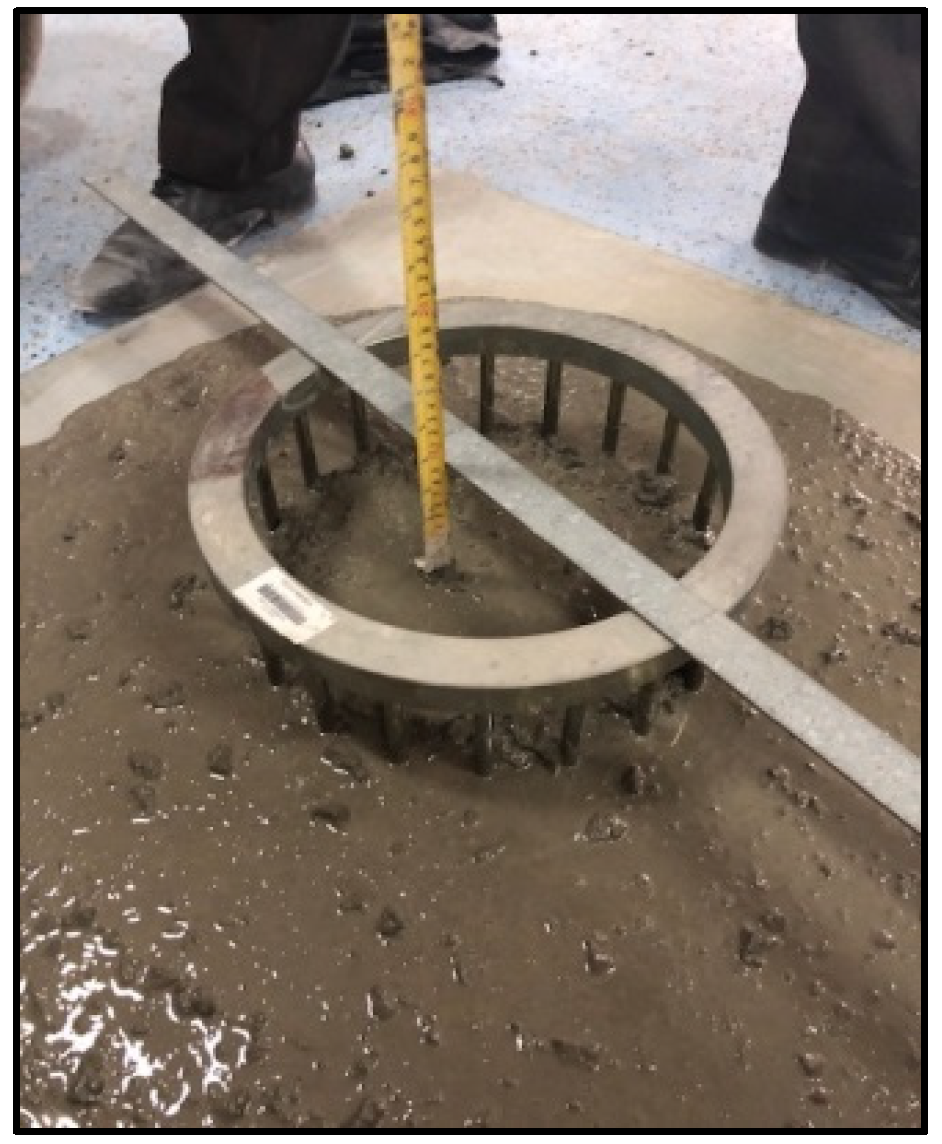

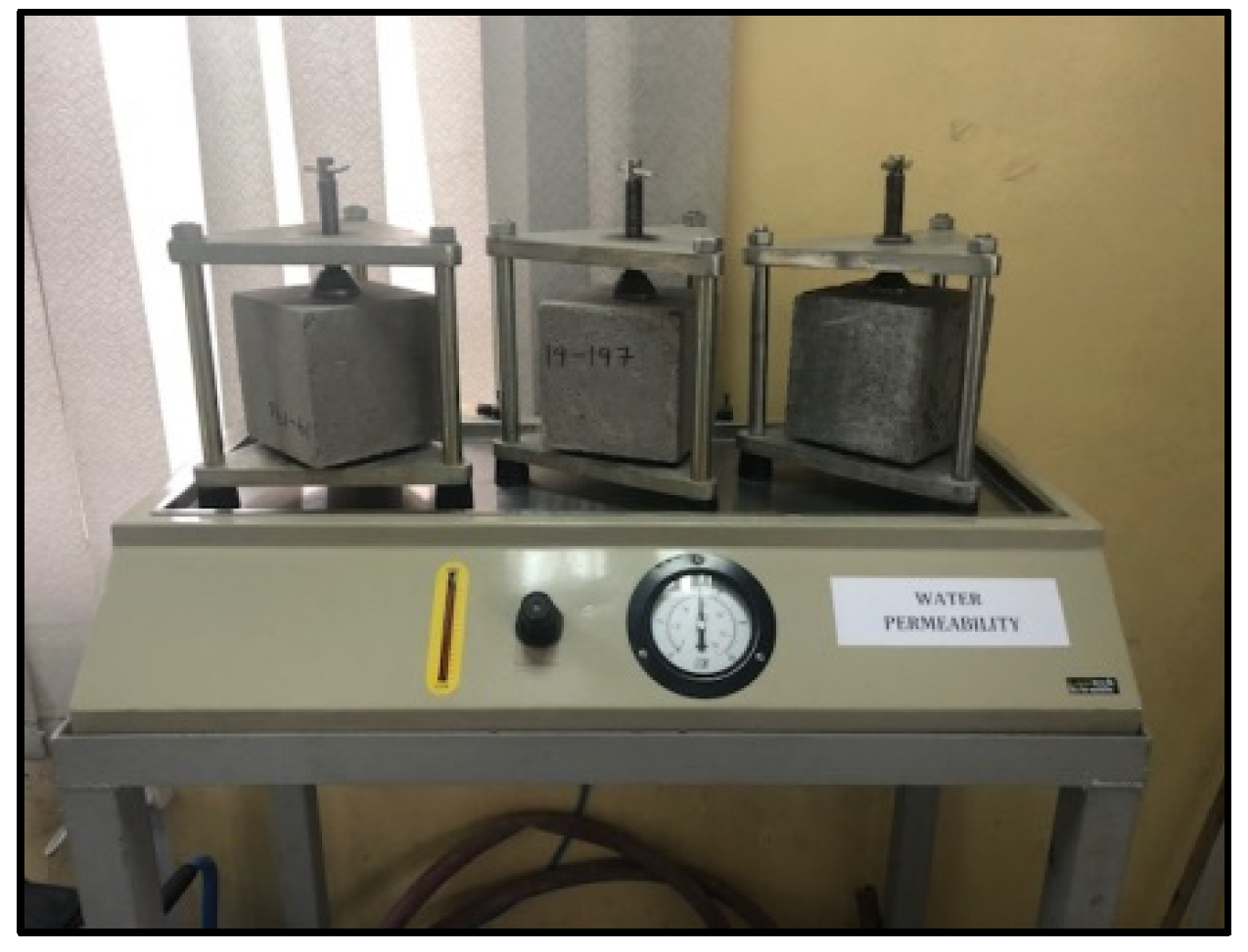
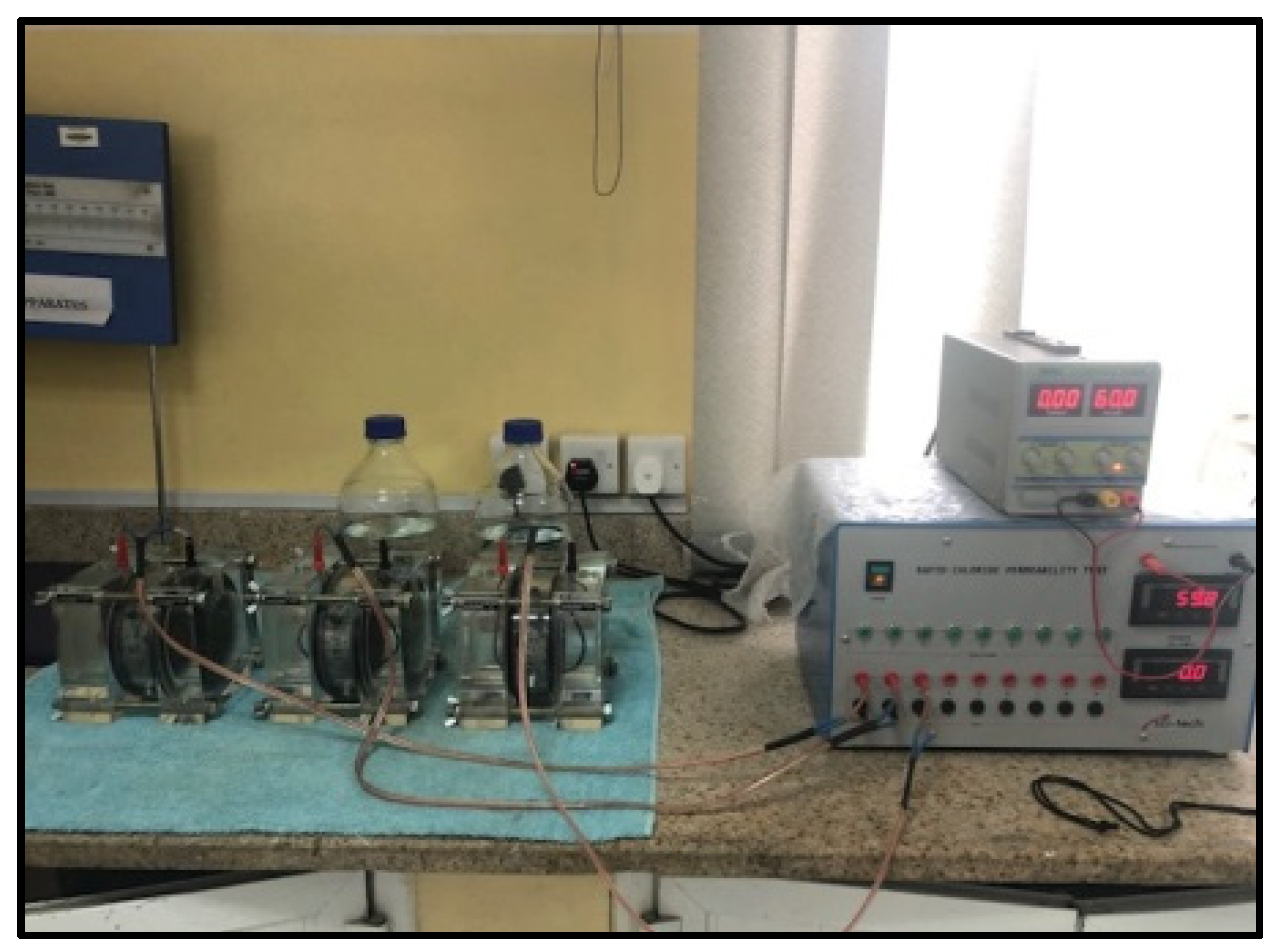
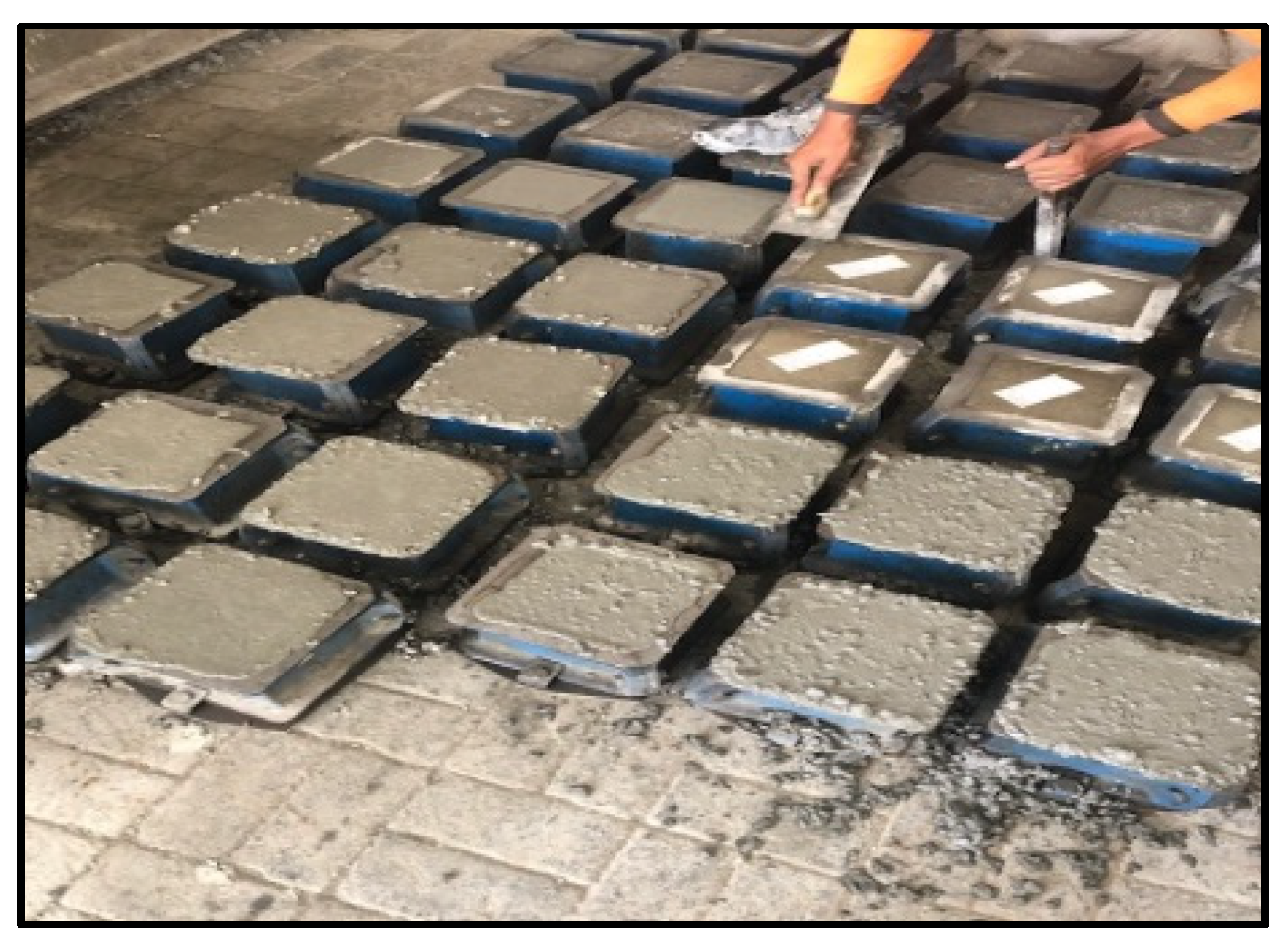
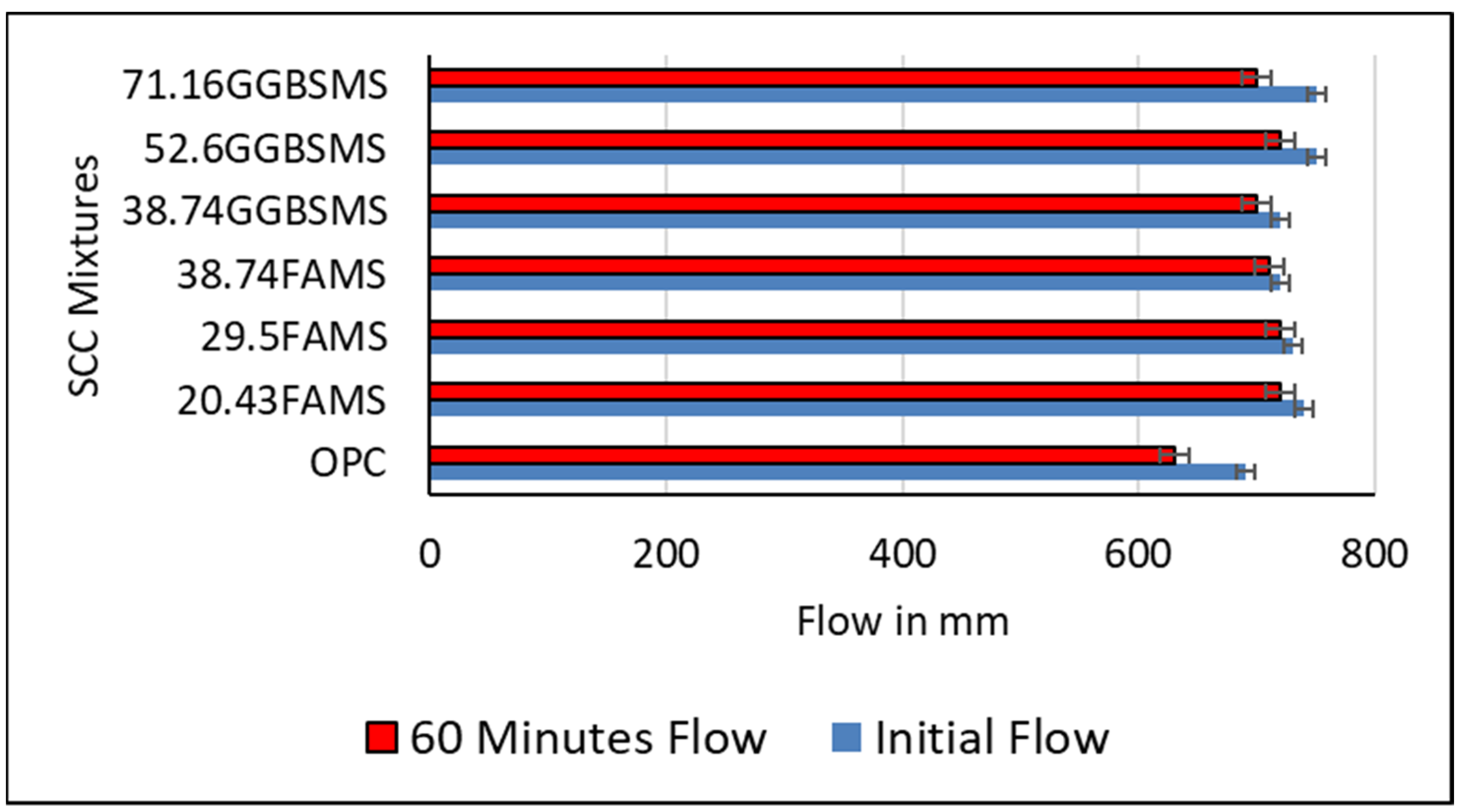


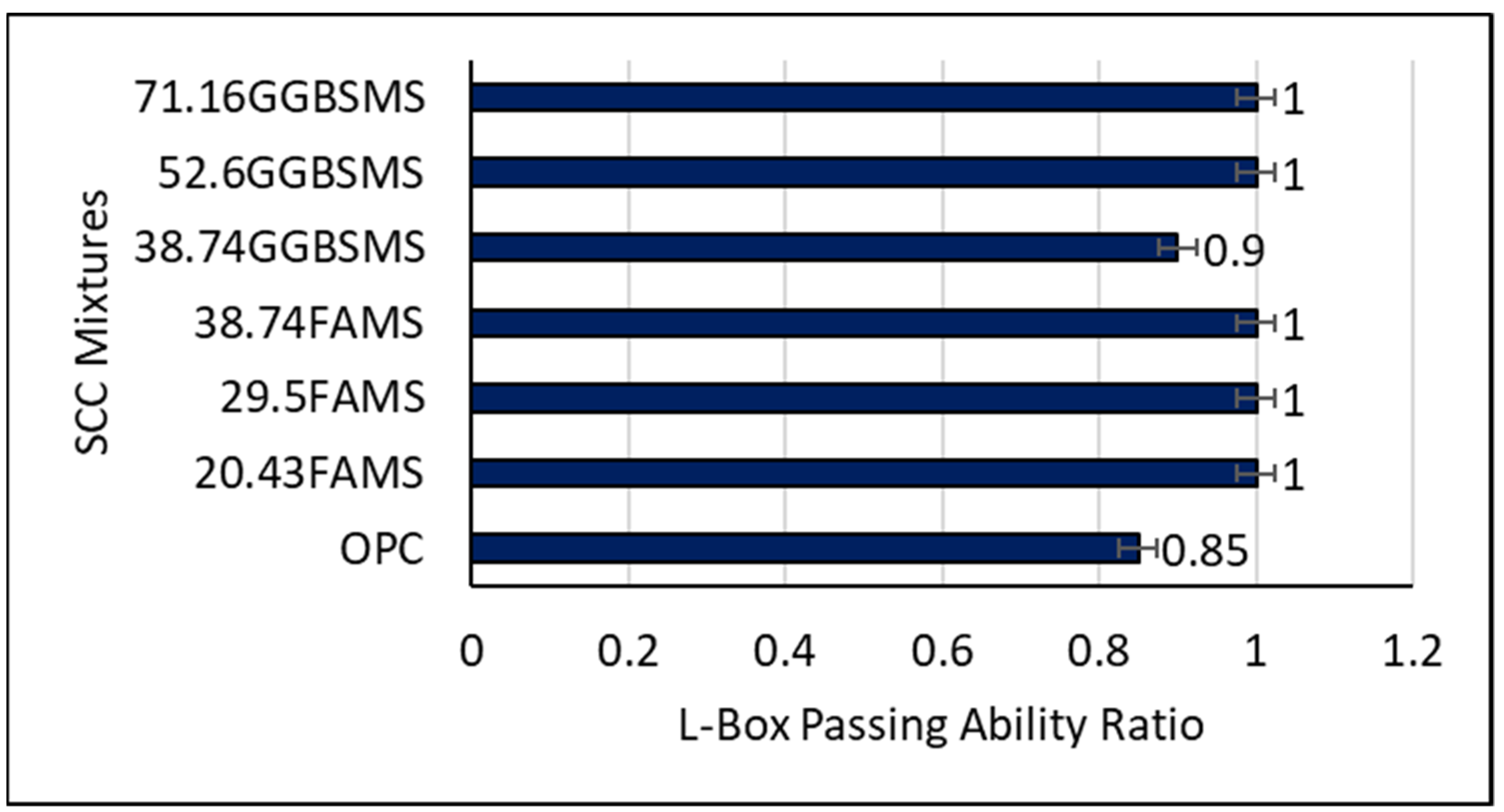
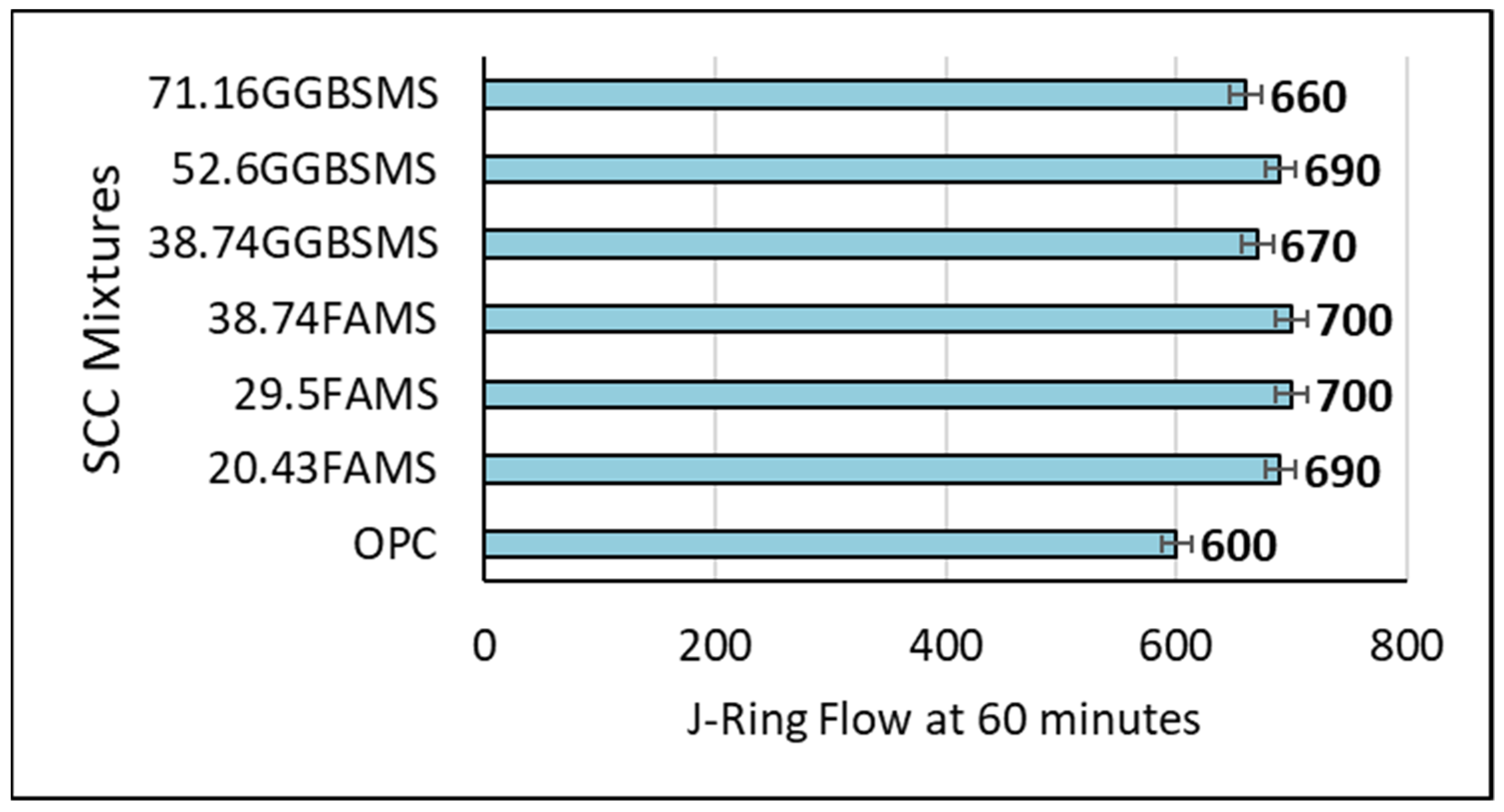

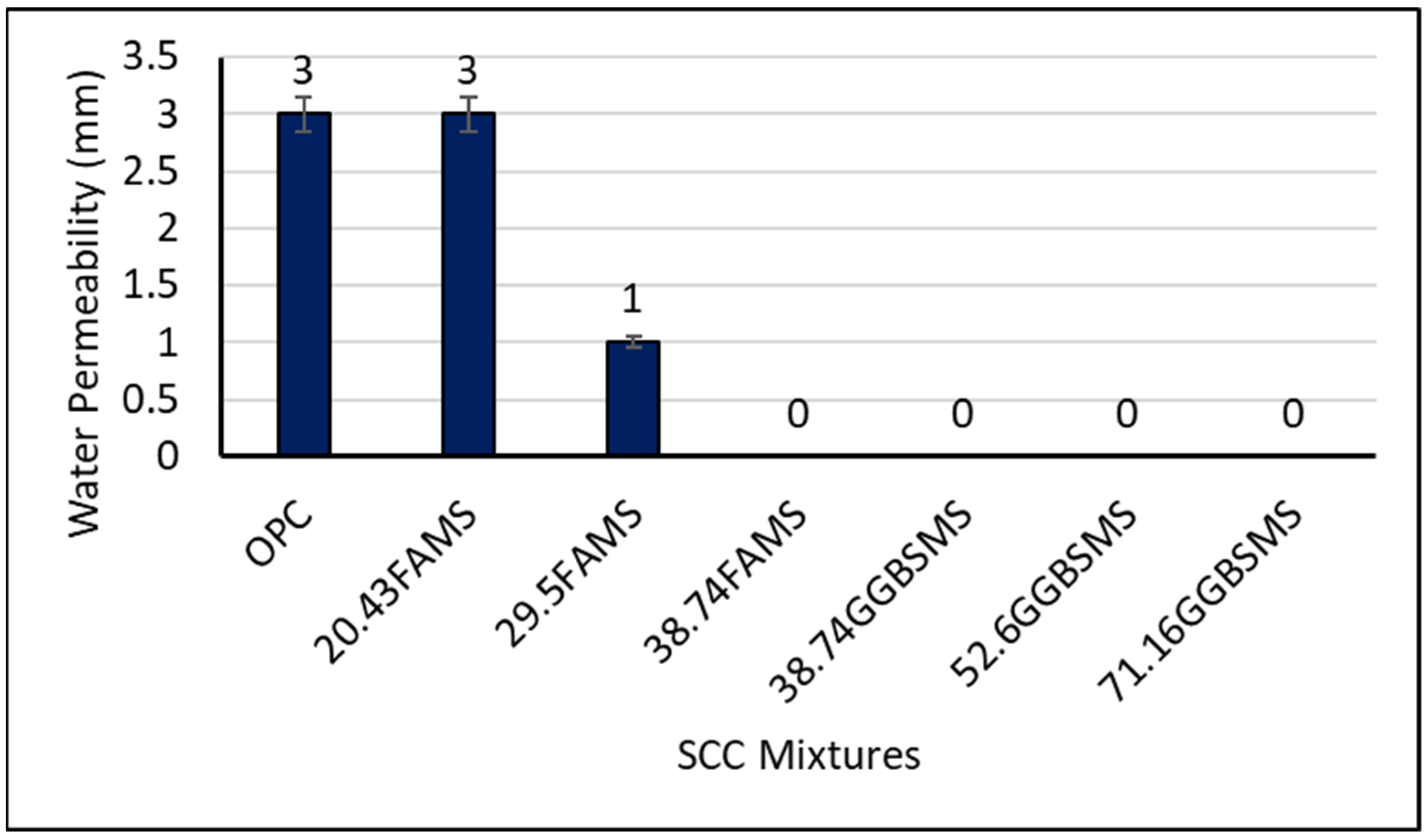


| Physical Properties | Specification | Results |
|---|---|---|
| Fineness (Air Permeability) | - | 3280 cm2/gm |
| Initial setting time | ≥60 | 205 Minutes |
| Final setting time | 265 Minutes | |
| Compressive Strength—2 Days | ≥10 | 25.05 MPa |
| Compressive Strength—7 Days | - | 40.22 MPa |
| Compressive Strength—28 Days | ≥42.50 and ≤62.50 | 53.77 MPa |
| Parameter | C3S | C2S | C3A | C4AF |
|---|---|---|---|---|
| Results | 57.37% | 13.83% | 6.82% | 11.32% |
| Chemical Composition % | SiO2 | Al2O3 | Fe2O3 | CaO | MgO | TiO2 | SO3 | Cl | Na2O | K2O | L.O.I |
|---|---|---|---|---|---|---|---|---|---|---|---|
| GGBS | 31.27 | 13.34 | 0.64 | 41.55 | 6.90 | 0.98 | 0.11 | 0.01 | - | - | - |
| FA | 47.78 | 29.74 | 5.2 | 5.57 | 3.20 | 1.99 | 0.63 | - | 0.97 | 0.96 | 2.42 |
| MS | 92.38 | - | - | - | - | - | - | - | 0.46 | - | 5.01 |
| GGBS | 1.78% |
|---|---|
| FA [58] | 13.30% |
| MS | 2% |
| Mixture Code | Mixture without MS (%) | Mixture with MS (%) | OPC kg/m3 | SCM kg/m3 | Aggregate | Sand | HRSP kg/m3 | Water kg/m3 | ||||
|---|---|---|---|---|---|---|---|---|---|---|---|---|
| FA | GGBS | MS | 20 mm | 10 mm | Washed Sand | Dune Sand | ||||||
| OPC | 100% OPC | 100% OPC | 470 | 0 | 0 | 0 | 331 | 395 | 726 | 386 | 6.8 | 155 |
| 20.43FAMS | 14.0% FA | 20.43% (FA + MS) | 374 | 66 | 0 | 30 | 338 | 401 | 711 | 374 | 6.5 | 155 |
| 29.5FAMS | 23.4% FA | 29.5% (FA + MS) | 330 | 110 | 0 | 30 | 336 | 399 | 707 | 372 | 6.7 | 155 |
| 38.74FAMS | 32.77% FA | 38.74% (FA + MS) | 286 | 154 | 0 | 30 | 335 | 397 | 704 | 370 | 6.8 | 155 |
| 38.74GGBSMS | 32.77% GGBS | 38.74% (GGBS + MS) | 286 | 0 | 154 | 30 | 339 | 402 | 713 | 375 | 6.5 | 155 |
| 52.6GGBSMS | 46.81% GGBS | 52.6% (GGBS + MS) | 220 | 0 | 220 | 30 | 338 | 401 | 711 | 374 | 6.8 | 155 |
| 71.16GGBSMS | 65.5% GGBS | 71.16% (GGBS + MS) | 132 | 0 | 308 | 30 | 337 | 399 | 708 | 373 | 7.0 | 155 |
| Mixture | OPC | 20.43% FAMS | 29.5% FAMS | 38.74% FAMS | 38.74% GGBSMS | 50.6% GGBSMS | 71.16% GGBSMS |
|---|---|---|---|---|---|---|---|
| kg/m3 | 2490 | 2475 | 2480 | 2460 | 2485 | 2470 | 2470 |
Publisher’s Note: MDPI stays neutral with regard to jurisdictional claims in published maps and institutional affiliations. |
© 2022 by the authors. Licensee MDPI, Basel, Switzerland. This article is an open access article distributed under the terms and conditions of the Creative Commons Attribution (CC BY) license (https://creativecommons.org/licenses/by/4.0/).
Share and Cite
Salih, M.A.; Ahmed, S.K.; Alsafi, S.; Abullah, M.M.A.B.; Jaya, R.P.; Abd Rahim, S.Z.; Aziz, I.H.; Thanaya, I.N.A. Strength and Durability of Sustainable Self-Consolidating Concrete with High Levels of Supplementary Cementitious Materials. Materials 2022, 15, 7991. https://doi.org/10.3390/ma15227991
Salih MA, Ahmed SK, Alsafi S, Abullah MMAB, Jaya RP, Abd Rahim SZ, Aziz IH, Thanaya INA. Strength and Durability of Sustainable Self-Consolidating Concrete with High Levels of Supplementary Cementitious Materials. Materials. 2022; 15(22):7991. https://doi.org/10.3390/ma15227991
Chicago/Turabian StyleSalih, Moslih Amer, Shamil Kamil Ahmed, Shaymaa Alsafi, Mohd Mustafa Al Bakri Abullah, Ramadhansyah Putra Jaya, Shayfull Zamree Abd Rahim, Ikmal Hakem Aziz, and I Nyoman Arya Thanaya. 2022. "Strength and Durability of Sustainable Self-Consolidating Concrete with High Levels of Supplementary Cementitious Materials" Materials 15, no. 22: 7991. https://doi.org/10.3390/ma15227991
APA StyleSalih, M. A., Ahmed, S. K., Alsafi, S., Abullah, M. M. A. B., Jaya, R. P., Abd Rahim, S. Z., Aziz, I. H., & Thanaya, I. N. A. (2022). Strength and Durability of Sustainable Self-Consolidating Concrete with High Levels of Supplementary Cementitious Materials. Materials, 15(22), 7991. https://doi.org/10.3390/ma15227991









